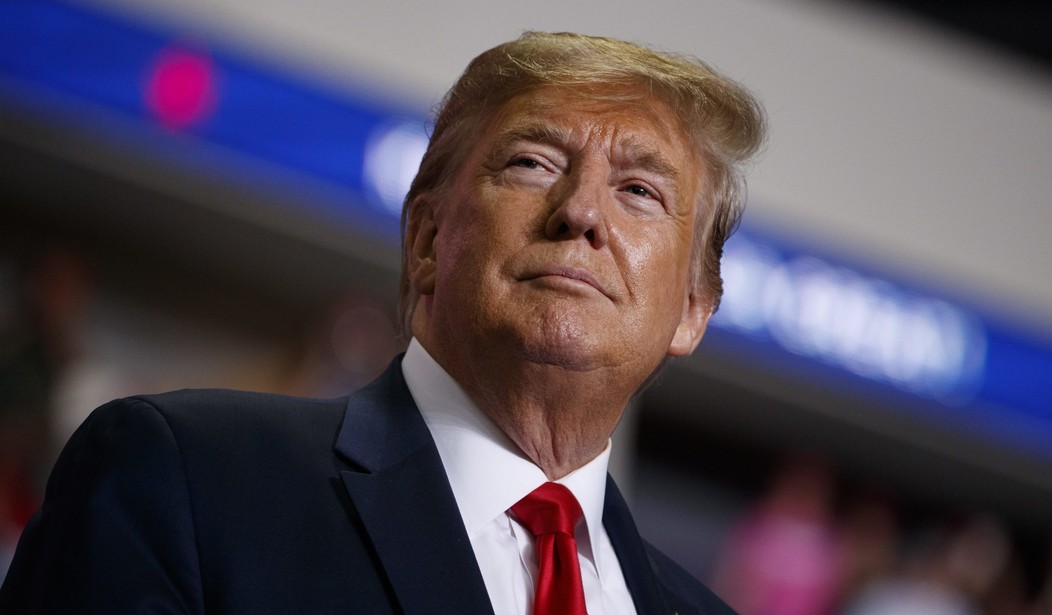How can a nontraditional GOP candidate beat a well-known Democrat who seemed to have most of her electoral ducks in a row — that’s the question we asked three years ago during the previous Wargaming the Electoral College series. As it turned out, the first winning scenario I explored for Trump, called “the northern route,” turned out to be the one that won him the election.
Here’s that map, which I published in July of 2016.

It was one of those But Only Donald Trump Can [Blank]™ victories. While the rest of the GOP contenders would have racked up huge wins in safe red states, Trump pitched his appeal at disaffected Democrats in the Rust Belt. If he didn’t win Texas as big as Ted Cruz might have, so what? Trump carried Texas and Pennsylvania.
If you’re spent the last four years under a rock — a rock without WiFi, for that matter — you might think that Trump would play it safe in 2020, working to deny the Democrat nominee much chance of winning back PA, MI, or WI. But a couple of items from the last few days indicate that Trump will double down on 2016’s winning formula, and try putting even more blue states into play next year.
Before we get to that, most pundits will begin 2020 with a map looking something like this one just below. We’ll call it the Conventional Wisdom Battlespace.

(All maps courtesy of 270toWin.)
But Trump doesn’t hew much to the conventional wisdom, does he?
Last week, Time’s Brian Bennett delivered a look inside Trump’s plan to flip even more blue states next year. The story begins in New Mexico, which hasn’t been won by a Republican since George W. Bush in 2004 — and even that was a very near thing. Nevertheless, Bennett reports that Team Trump “is planning to announce a state director and additional ground staff there in the coming weeks.” The play is to “energize a slice of the state’s Hispanic voters” just big enough to turn it red. Jared Kushner told Time, “I can see us very aggressively playing in 18 swing states,” as opposed to just 11 last time around.
What would those states be? Kushner can’t be speaking of only states Clinton won in 2016, because she won only 19 states (plus D.C.). Clearly then Kushner is talking about battlegrounds both blue and red.
Let’s do what I did in 2016: Throw away the pundit’s map we looked at a moment ago, and broaden the playing field to the widest likely realm.

Both Trump and Candidate D can count for sure on about the same number of Electoral College (EC) votes: 181 (R) to 176 (D). Add in the leaners for both sides, and you get 224 for Trump versus just 213 for Candidate D… but that still leaves both sides well short of the magic 270.
CO and VA used to be competitive, but the influx of Californians into the former and government workers into the latter are obstacles perhaps too big to overcome in the short term. Democrats are working hard to turn AZ, GA, and NC, but if they couldn’t put Stacy Adams over the top in a year heavily favoring the Dems, then I don’t see GA in play in 2020. Similar story in NC: The MSM-DNC poured everything they could into that special congressional election recently, yet still came up short. NC looks relatively safe. And AZ is still red enough that freshman Dem Senator Kristen Sinema is tacking to the center.
So our battlegrounds are FL, PA, NH, MI, WI, IA, MN, NM, and maybe NV. Add those together and we’re not even close to the number of states (18) Kushner was talking about contesting. Throw red-leaners AZ, GA, NC, and OH back into the mix, and we’re still shy by five battleground states. Which blue ones might Trump try to peel away? I guess that means putting CO and VA back on the playing board… but we need three more.
We’re getting deep into blue country here, but based on recent reports, my best guess is that Trump’s game plan looks like this:

Even putting NJ and OR into play, I could still get only to 17 battlegrounds. What is Kushner’s 18th state? IL? NY? DE? I just can’t spot it — can you?
But the point is this: Trump wants to broaden the battlespace enough that a clean sweep would give him the biggest GOP win since George Bush ran for Reagan’s third term in 1988. (Bush declined to deliver Reagan’s third term; voters declined to reelect him.)
Here’s what that sweep would look like:

The real kicker? A bunch of states have signed on to the National Popular Vote Interstate Compact. If Trump wins the popular vote, he’ll carry the entire West Coast (including Hawaii), plus Colorado, Illinois, Maryland, Delaware, New York, and the bulk of New England’s ECs. Even being super-generous and letting the Dems hold on to MN in the case of a Trump landslide, look at what the NPV compact could do to the map.

(NPV states in light red.)
I would expect that if the election starts looking like a blowout, you’ll see an awful lot of blue state assemblies scrambling to see who can pull out of the compact the fastest. Failing that, some well-financed moderate Dem or NeverTrumper might just jump in, in an effort to deny Trump a popular majority.
But back to Trump’s expanded battlespace. Playing in places like New Jersey and Oregon is quite the longshot, but unlike any other Republican candidate of recent vintage, Trump is willing to try.
That alone makes me really like his chances — not just of winning, but of winning bigger than many people expect.










Join the conversation as a VIP Member